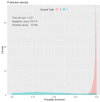Development and validation of a prognosis risk score model for preterm birth among pregnant women who had antenatal care visit, Northwest, Ethiopia, retrospective follow-up study
- PMID: 37848836
- PMCID: PMC10583360
- DOI: 10.1186/s12884-023-06018-1
Development and validation of a prognosis risk score model for preterm birth among pregnant women who had antenatal care visit, Northwest, Ethiopia, retrospective follow-up study
Abstract
Background: Prematurity is the leading cause of neonatal morbidity and mortality, specifically in low-resource settings. The majority of prematurity can be prevented if early interventions are implemented for high-risk pregnancies. Developing a prognosis risk score for preterm birth based on easily available predictors could support health professionals as a simple clinical tool in their decision-making. Therefore, the study aims to develop and validate a prognosis risk score model for preterm birth among pregnant women who had antenatal care visit at Debre Markos Comprehensive and Specialized Hospital, Ethiopia.
Methods: A retrospective follow-up study was conducted among a total of 1,132 pregnant women. Client charts were selected using a simple random sampling technique. Data were extracted using structured checklist prepared in the Kobo Toolbox application and exported to STATA version 14 and R version 4.2.2 for data management and analysis. Stepwise backward multivariable analysis was done. A simplified risk prediction model was developed based on a binary logistic model, and the model's performance was assessed by discrimination power and calibration. The internal validity of the model was evaluated by bootstrapping. Decision Curve Analysis was used to determine the clinical impact of the model.
Result: The incidence of preterm birth was 10.9%. The developed risk score model comprised of six predictors that remained in the reduced multivariable logistic regression, including age < 20, late initiation of antenatal care, unplanned pregnancy, recent pregnancy complications, hemoglobin < 11 mg/dl, and multiparty, for a total score of 17. The discriminatory power of the model was 0.931, and the calibration test was p > 0.05. The optimal cut-off for classifying risks as low or high was 4. At this cut point, the sensitivity, specificity and accuracy is 91.0%, 82.1%, and 83.1%, respectively. It was internally validated and has an optimism of 0.003. The model was found to have clinical benefit.
Conclusion: The developed risk-score has excellent discrimination performance and clinical benefit. It can be used in the clinical settings by healthcare providers for early detection, timely decision making, and improving care quality.
Keywords: Ethiopia; Pregnant women; Preterm birth; Prognosis model; Risk score.
© 2023. BioMed Central Ltd., part of Springer Nature.
Conflict of interest statement
The authors declare no competing interests.
Figures






Similar articles
-
Development and validation of a simplified risk prediction model for preterm birth: a prospective cohort study in rural Ethiopia.Sci Rep. 2024 Feb 28;14(1):4845. doi: 10.1038/s41598-024-55627-z. Sci Rep. 2024. PMID: 38418507 Free PMC article.
-
Development and validation of a nomogram for predicting low birth weight among pregnant women who had antenatal care visits at Debre Markos Comprehensive and Specialized Hospital, Ethiopia.Front Med (Lausanne). 2023 Nov 28;10:1253490. doi: 10.3389/fmed.2023.1253490. eCollection 2023. Front Med (Lausanne). 2023. PMID: 38093980 Free PMC article.
-
Incidence and development of validated mortality prediction model among asphyxiated neonates admitted to neonatal intensive care unit at Felege Hiwot Comprehensive Specialized Hospital, Bahir Dar, Northwest Ethiopia, 2021: retrospective follow-up study.BMC Pediatr. 2024 Mar 28;24(1):219. doi: 10.1186/s12887-024-04696-0. BMC Pediatr. 2024. PMID: 38539138 Free PMC article.
-
Is intimate partner violence and obstetrics characteristics of pregnant women associated with preterm birth in Ethiopia? Umbrella review on preterm birth.Reprod Health. 2023 Nov 17;20(1):168. doi: 10.1186/s12978-023-01716-7. Reprod Health. 2023. PMID: 37978546 Free PMC article.
-
Strategies for optimising antenatal corticosteroid administration for women with anticipated preterm birth.Cochrane Database Syst Rev. 2020 May 26;5(5):CD013633. doi: 10.1002/14651858.CD013633. Cochrane Database Syst Rev. 2020. PMID: 32452555 Free PMC article.
Cited by
-
Development and validation of a simplified risk prediction model for preterm birth: a prospective cohort study in rural Ethiopia.Sci Rep. 2024 Feb 28;14(1):4845. doi: 10.1038/s41598-024-55627-z. Sci Rep. 2024. PMID: 38418507 Free PMC article.
-
An update review of the application of single-cell RNA sequencing in pregnancy-related diseases.Front Endocrinol (Lausanne). 2024 Dec 9;15:1415173. doi: 10.3389/fendo.2024.1415173. eCollection 2024. Front Endocrinol (Lausanne). 2024. PMID: 39717096 Free PMC article. Review.
References
-
- USAID P. GAPPS A. Profile of Preterm and Low Birth Weight Prevention and Care-Ethiopia.; 2017. 2019.
-
- WHO.“Preterm birth,“. Available online: https://www.who.int/newsroom/fact-sheets/detail, Accessed 19 February 2022.
-
- Central Statistical. Agency (CSA) [Ethiopia], ICF. Ethiopia Demographic and Health Survey; 2016.
-
- WHO.“Newborn Mortality”. Available online: https://www.who.int/newsroom/fact-sheets/detail, Accessed 28 January 2022.
MeSH terms
LinkOut - more resources
Full Text Sources

